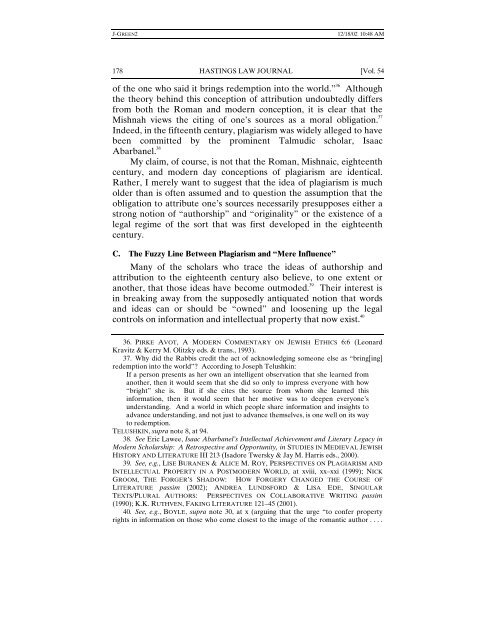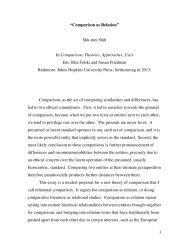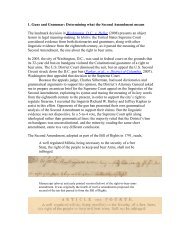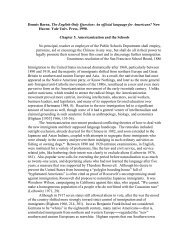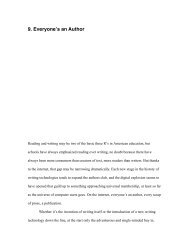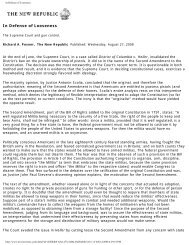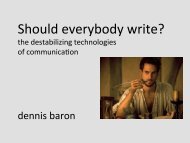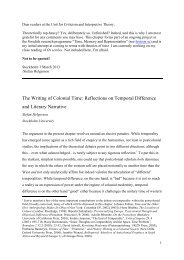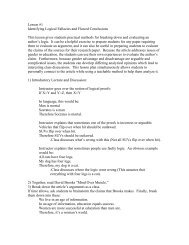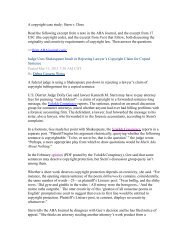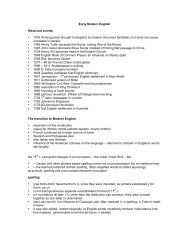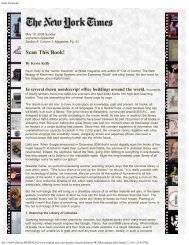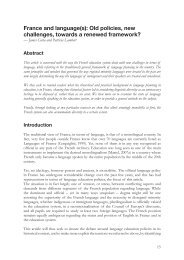Plagiarism, Norms, and the Limits of Theft Law: Some ... - English
Plagiarism, Norms, and the Limits of Theft Law: Some ... - English
Plagiarism, Norms, and the Limits of Theft Law: Some ... - English
You also want an ePaper? Increase the reach of your titles
YUMPU automatically turns print PDFs into web optimized ePapers that Google loves.
J-GREEN2 12/18/02 10:48 AM<br />
178 HASTINGS LAW JOURNAL [Vol. 54<br />
<strong>of</strong> <strong>the</strong> one who said it brings redemption into <strong>the</strong> world.” 36 Although<br />
<strong>the</strong> <strong>the</strong>ory behind this conception <strong>of</strong> attribution undoubtedly differs<br />
from both <strong>the</strong> Roman <strong>and</strong> modern conception, it is clear that <strong>the</strong><br />
Mishnah views <strong>the</strong> citing <strong>of</strong> one’s sources as a moral obligation. 37<br />
Indeed, in <strong>the</strong> fifteenth century, plagiarism was widely alleged to have<br />
been committed by <strong>the</strong> prominent Talmudic scholar, Isaac<br />
Abarbanel. 38<br />
My claim, <strong>of</strong> course, is not that <strong>the</strong> Roman, Mishnaic, eighteenth<br />
century, <strong>and</strong> modern day conceptions <strong>of</strong> plagiarism are identical.<br />
Ra<strong>the</strong>r, I merely want to suggest that <strong>the</strong> idea <strong>of</strong> plagiarism is much<br />
older than is <strong>of</strong>ten assumed <strong>and</strong> to question <strong>the</strong> assumption that <strong>the</strong><br />
obligation to attribute one’s sources necessarily presupposes ei<strong>the</strong>r a<br />
strong notion <strong>of</strong> “authorship” <strong>and</strong> “originality” or <strong>the</strong> existence <strong>of</strong> a<br />
legal regime <strong>of</strong> <strong>the</strong> sort that was first developed in <strong>the</strong> eighteenth<br />
century.<br />
C. The Fuzzy Line Between <strong>Plagiarism</strong> <strong>and</strong> “Mere Influence”<br />
Many <strong>of</strong> <strong>the</strong> scholars who trace <strong>the</strong> ideas <strong>of</strong> authorship <strong>and</strong><br />
attribution to <strong>the</strong> eighteenth century also believe, to one extent or<br />
ano<strong>the</strong>r, that those ideas have become outmoded. 39 Their interest is<br />
in breaking away from <strong>the</strong> supposedly antiquated notion that words<br />
<strong>and</strong> ideas can or should be “owned” <strong>and</strong> loosening up <strong>the</strong> legal<br />
controls on information <strong>and</strong> intellectual property that now exist. 40<br />
36. PIRKE AVOT, A MODERN COMMENTARY ON JEWISH ETHICS 6:6 (Leonard<br />
Kravitz & Kerry M. Olitzky eds. & trans., 1993).<br />
37. Why did <strong>the</strong> Rabbis credit <strong>the</strong> act <strong>of</strong> acknowledging someone else as “bring[ing]<br />
redemption into <strong>the</strong> world”? According to Joseph Telushkin:<br />
If a person presents as her own an intelligent observation that she learned from<br />
ano<strong>the</strong>r, <strong>the</strong>n it would seem that she did so only to impress everyone with how<br />
“bright” she is. But if she cites <strong>the</strong> source from whom she learned this<br />
information, <strong>the</strong>n it would seem that her motive was to deepen everyone’s<br />
underst<strong>and</strong>ing. And a world in which people share information <strong>and</strong> insights to<br />
advance underst<strong>and</strong>ing, <strong>and</strong> not just to advance <strong>the</strong>mselves, is one well on its way<br />
to redemption.<br />
TELUSHKIN, supra note 8, at 94.<br />
38. See Eric <strong>Law</strong>ee, Isaac Abarbanel’s Intellectual Achievement <strong>and</strong> Literary Legacy in<br />
Modern Scholarship: A Retrospective <strong>and</strong> Opportunity, in STUDIES IN MEDIEVAL JEWISH<br />
HISTORY AND LITERATURE III 213 (Isadore Twersky & Jay M. Harris eds., 2000).<br />
39. See, e.g., LISE BURANEN & ALICE M. ROY, PERSPECTIVES ON PLAGIARISM AND<br />
INTELLECTUAL PROPERTY IN A POSTMODERN WORLD, at xviii, xx–xxi (1999); NICK<br />
GROOM, THE FORGER’S SHADOW: HOW FORGERY CHANGED THE COURSE OF<br />
LITERATURE passim (2002); ANDREA LUNDSFORD & LISA EDE, SINGULAR<br />
TEXTS/PLURAL AUTHORS: PERSPECTIVES ON COLLABORATIVE WRITING passim<br />
(1990); K.K. RUTHVEN, FAKING LITERATURE 121–45 (2001).<br />
40. See, e.g., BOYLE, supra note 30, at x (arguing that <strong>the</strong> urge “to confer property<br />
rights in information on those who come closest to <strong>the</strong> image <strong>of</strong> <strong>the</strong> romantic author . . . .


